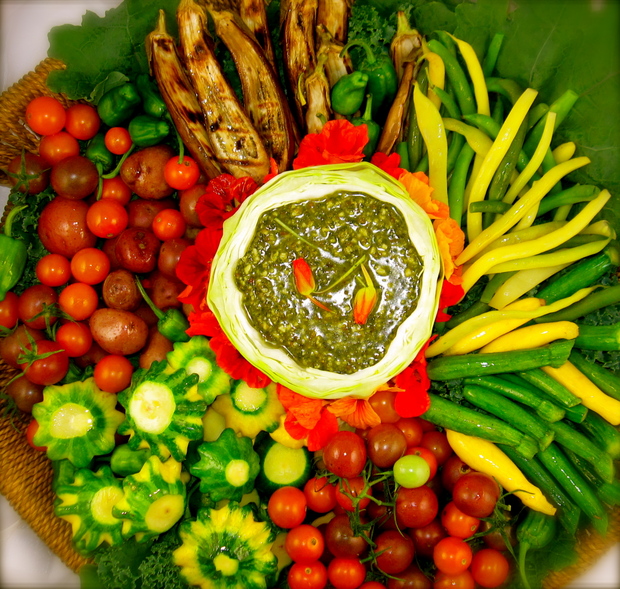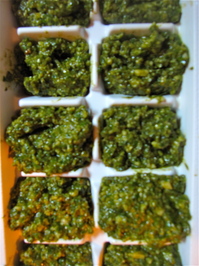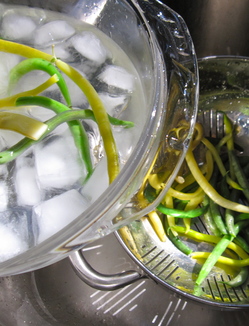Peggy Lampman's Thursday dinnerFeed: Farmers Market Baby Vegetables with Pesto

Baby Vegetables with Basil Pesto
Peggy Lampman | Contributor

Unless we've fallen into the rabbit hole, nature's folly will end likely in a couple of short months. Many of you are canning, drying and preserving the bounty to enjoy in the cold months ahead. I keep planning to do this but haven't carved out the time. I always, however, find the time to put up pesto. It's just too easy.

Freezing pesto in ice cube trays.
The word "pesto" is derived from the Italian verb "pestare" meaning "to crush, grind or pound." Most associate pesto with fresh basil and pine nuts, but any savory herb paste is fair game for wearing the pesto moniker. Past pesto recipes I've enjoyed, for example, have included almond and dill, wasabi and cilantro, and mint and feta combinations.
Think outside of the pasta box, as well, when using pesto in recipes. In addition to tossing with freshly cooked pasta, pesto is delicious smeared into a sandwich before grilling, topping freshly cooked fish or chicken, mashed with potatoes or stirred into hot soup. While the beautiful local produce remains, I'm serving traditional basil pesto, thinned with a bit of olive oil, with fresh baby vegetables.

Drain vegetables, then plunge into an icy bath to stop cooking and inject a vibrant color.
In the fabled Wonderland tale, the grinning Cheshire Cat, like our locally grown produce, slowly vanishes in the air. The cat's grin, however, remains visible, hovering about, much like the frozen pesto you've stashed in your freezer. You may catch yourself grinning while enjoying fresh pesto through the winter!
Ingredients for Vegetables*
6 baby eggplant, cut lengthwise in half
1/4 cup extra virgin olive oil, plus extra for brushing on vegetables
2-3 cups baby zucchini
2-3 cups green beans
2-3 cups pattypan squash, sliced sandwich-style through center if larger than 1 inch
3 cups baby potatoes, assorted varieties if available
3 cups cherry tomatoes, assorted varieties if available
3 cups mild baby Mexican peppers
1 small cabbage
1 cup pesto (recipe follows)
*My vegetables are merely suggestions; what I found that appealed to me at the market. Let the farmer's freshly harvested yield dictate your choice.
Directions for Vegetable Platter
1. Prepare gas or charcoal fire to medium heat. Lightly brush eggplant flesh with olive oil and grill 2-4 minutes on each side or until flesh is tender but not charred. Remove and lightly sprinkle with kosher salt ; reserve.
2. Bring 4 pots of salted water to a boil*. Fill a large, wide bowl with ice water.
3. In one pot, boil potatoes 8-12 minute or until just tender and easily pierced with a fork. Drain and cool under cold running water.
4. In another pot, boil patty pans 30 seconds to 1 1/2 minutes, depending on their size. Drain then plunge into ice water.
5. In the third pot, boil baby zucchini 30 seconds to 1 minute; drain then plunge into ice water.
6. In the last pot, boil green beans 2-4 minutes or until crisp-tender; drain then plunge into ice water.
7. With a sharp knife, cut off bottom of cabbage so it will sit firmly on a platter. Cut off top half and reserve for another use. With a melon baller or sharp spoon, scoop out interior of cabbage, leaving 1/4-inch shell. Center on large platter.
8. Combine pesto with 1/4 cup olive oil and mix well; spoon into cabbage shell. Pat vegetables dry and arrange around pesto dip. Vegetable platter may be made up to 2 hours before serving.
*If green beans and squash are small enough and freshly harvested, you may prefer not blanching.
Ingredients for Pesto
1 cup pine nuts
4 large cloves of garlic, peeled

8 cups packed freshly harvested basil leaves, washed, stems and flowers removed

1 1/2-2 cups extra virgin olive oil

2 cups grated Parmigianno Reggiano* *Omit the Reggiano if you're freezing the pesto. Simply add it back after the pesto is thawed.
Directions for Pesto
1. Preheat oven or toaster oven to 350 degrees.*

2. Toast the pine nuts and garlic in the oven until the pine nuts are golden brown, about 5-7 minutes. 

3. In a food processor, purée the garlic with 2 tablespoons oil until smooth. Add the pine nuts to the bowl and, with off and on pulses, pulse until semi-puréed yet coarse. With a spatula, scrape garlic-nut mixture from the bowl into another bowl and reserve. 

4. Working in batches, place the basil leaves in the food processor and, with the addition of remaining olive oil, purée until smooth. Combine basil mixture with garlic-nut mixture. Stir in Parmesan and season to taste with kosher salt and freshly ground pepper. The pesto will remain fresh, tightly covered, several days refrigerated. You may also spoon into ice cube trays and freeze them to use as desired.
*To sweeten and soften the flavor of the garlic, and add a toasted component to the pine nut flavor, I toast them. This step may be omitted.

